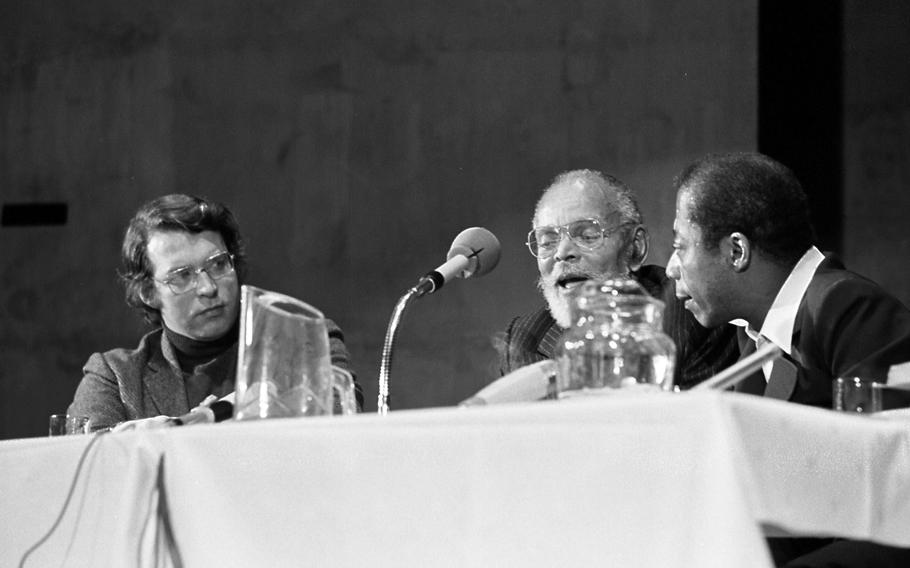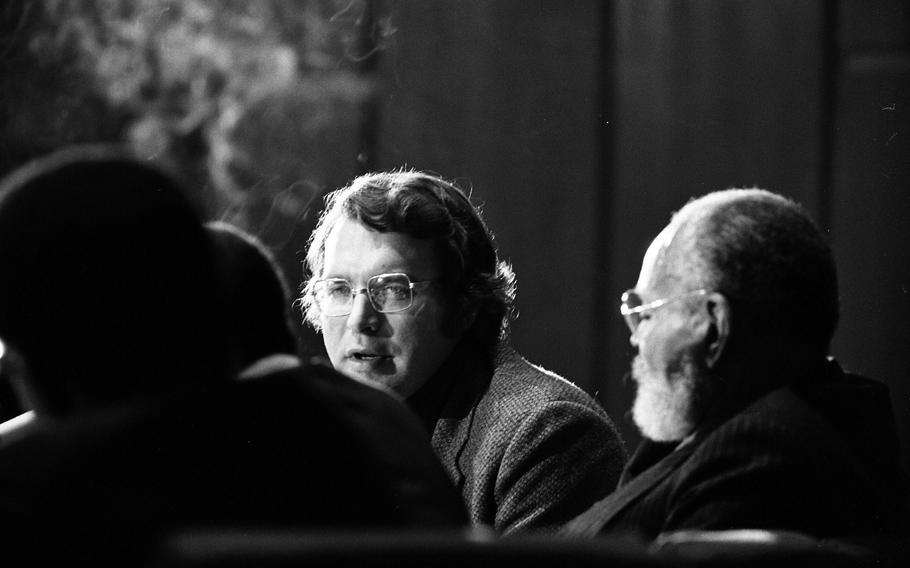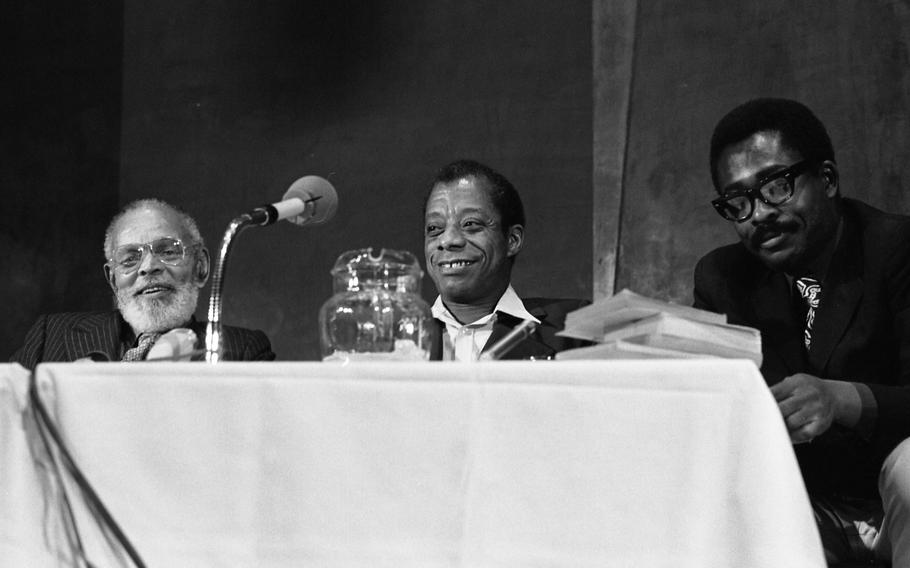
Chester Himes, left, and James Baldwin at Stuttgart, Germany, in February, 1973. (Regis Bossu/Stars and Stripes)
This article first appeared in print in the Stars and Stripes European edition, Feb. 27, 1973. It is republished unedited in its original form.
Chester Himes, known to most people probably only through the filming of his book, “Cotton Comes to Harlem,” is actually the author of 14 books, many of which are “serious” novels, far from the detective genre.
He is articulate and frank, and ready to discuss any subject — for example, his relationship to black militants:
“I don’t know what my relationship is. As a matter of fact, I doubt if they know who I am. All I can say is that, when I do go to New York, I meet quite a few young people who are active and we get along very well. As far as I know, the militants may consider me some kind of Uncle Tom.”

Moderator Gary Stevens listens as authors Chester Himes and James Baldwin talk. (Regis Bossu/Stars and Stripes)
Actually, Himes has been writing protest literature in one form or another since 1934, when his short story, To What Red Hell, written in prison, appeared in Esquire.
“My so-called protest novel, If He Hollers Let Him Go, was the kind of black literature that’s popular today. I’m not so sure if that’s the most effective way of getting the message across,” Himes said.
Himes is pleased with the fact that I knew his essay, The Dilemma of the Negro Novelist in the USA, which was written more than a quarter of a century ago. He is pleased and relieved that he doesn’t have to cover ground that he so articulately expressed.

Moderator Gary Stevens poses a question to authors Chester Himes and James Baldwin at the “Black Literature Night” and “Discussion of the Racial Situation in America and Europe” at the Liederhalle in Stuttgart, Feb. 16, 1973. Himes’ “Black on Black,” a collection of short stories, essays and a film scenario was published the same month. (Regis Bossu/Stars and Stripes)
How does Himes feel about the hate syndrome he described in his essay? “I think it still holds true. As a matter of fact, I wouldn’t care to change a word of that entire essay.”
Himes wrote: “There are, of course, truly thoughtful, sincere, sympathetic white people who will shudder in protest at the statement that all American Negroes hate all American whites.
“Of course, Negroes hate white people, far more actively than white people hate Negroes. What short of idiocy is it that reasons American Negroes don’t hate American whites? Can you abuse, enslave, persecute, segregate and generally oppress a people and have them love you for it? Are white people expected not to hate their oppressors? At some time in the lives of every American Negro there has been this hatred for white people: there are no exceptions. It could not possibly be otherwise.
“Yes, hate is an ugly word. It is an ugly emotion. It would be wonderful to say there is not hate; to say, we do not hate. But to merely speak the words would not make it so; it would not help us, who are Negroes, rid ourselves of hate. It would not help you, who are not Negroes, rid yourselves of hate. And it would not aid in the removal of the causes for which we hate.”
Himes then ends his essay on this note: “There is an indomitable quality within the human spirit that can not be destroyed … Growth. Growth is the surviving influence in all lives …
“It is a long way, a hard way from the hatred of faces to the hatred of evil, a longer way still to the brotherhood of men. Once on the road, however, the Negro will discover that he is not alone. The white people who he will encounter along the way may not appear to be accompanying him. But all, black and white, will be growing.”

Authors Chester Himes (left) and James Baldwin (middle) at the “Black Literature Night” and “Discussion of the Racial Situation in America and Europe” at the Liederhalle in Stuttgart, Feb. 16, 1973. (Regis Bossu/Stars and Stripes)
The filming of two of his novels did cause a Himes renaissance of sorts. What does he think of the films?
“You know, I went to see ‘Cotton Comes to Harlem’ and didn’t recognize it. I was on a talk show in New York and told the moderator that I thought they had made minstrel shows out of my books. Goldwyn called me and protested, but his films have precious little to do with many novels. I wrote what I thought was a satire — a white, Colonel Calhoun coming to Harlem to recruit blacks to pick cotton in the South and the black gangster trying to make money on a type of Garvey-back-to-Africa scheme. But they left Calhoun out of the film and had to use a lot of little tricks to make the film move. But, you see, this has nothing to do with the white-black problem. All writers, even Hemingway, have nothing to say about what kind of film Hollywood will make.”
Read Ed Reavis’ article on fellow Black author James Baldwin’s visit to Stuttgart here.
Reporter Ed Reavis’ wide knowledge showed in the wide variety of stories he covered for Stars and Stripes from 1972 to 1998, many of which led to changes within the military and brought him awards. He died in 2008. Check out more of his work in our historic archive. We have digitized our 1948-1999 European and Pacific editions, as well as several of our WWII editions and made them available online through https://starsandstripes.newspaperarchive.com/
You can read Stars and Stripes 2008 obituary for Ed Reavis here.